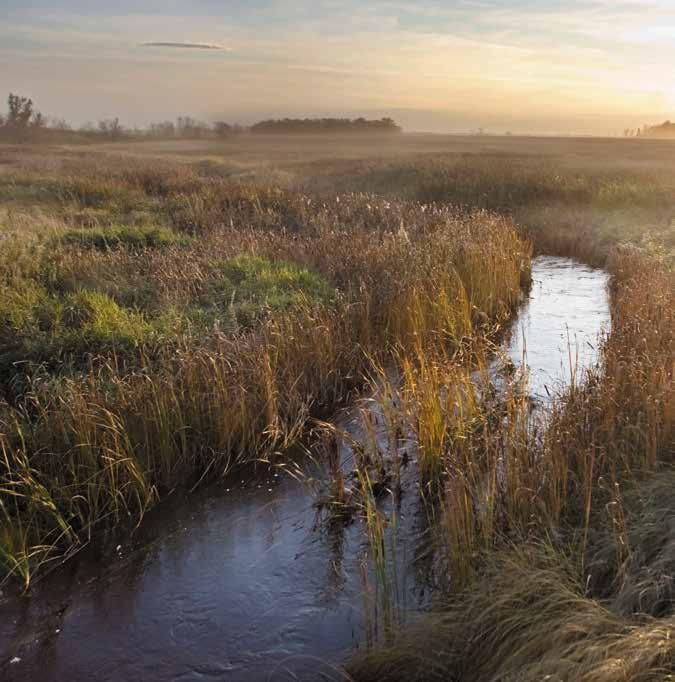
12 minute read
Yield: Taking Measure of the Land
photo by Shawna Widdel
by Scott Stevens
Advertisement
In my father’s personal mythology of North Dakota, nothing captured the brutal intensity of life as his frequent reference to working “from can see ‘til can’t.” In the last years of his life, I greedily asked about his boyhood in Sarles each time we were together. Less interested in events than a way of life, I acted as scribe for loose bits of memory that captured how the family lived in the 1920s and 30s: the distressed farm, the low house without electricity or light, the tenuous four-mile tether to the smallest of towns. There was little romance in my father’s stories, almost no reverie of childhood, just a reliable well of hardship, deprivation, and work. Always work. Soil bears the fruit of effort, not intention, so the axis of daily life was the energy inhabitants put into the land because everything depended on what the land would yield. Robert Frost understood this unsentimental calculus of a life lived close to the earth when he wrote, “The fact is the sweetest dream that labor knows.”
In those northern summers, “can’t” came late. As my father often reminisced, there wasn’t much else again until first light. It’s common now to speak of North Dakota with a kind of twilight reverie—children the primary export, an unchecked exodus of talent and heart, whole towns eclipsing into “can’t see.” In the uncertainties of this fading light, we are left to wrestle with the legacies of place and what the land produced. Philosophers of geography study the effect of place on us and consider how we develop a “geographical self” dependent on the landscapes we inhabit. In essence, they ask what the land asks of us: how a place like North Dakota grows beliefs alongside bushels, cultivating in its people distinctive ways of thinking and feeling.
In 2004, I returned to my father’s birthplace to understand the weight of geography, the magnitude of this place his memory could never leave behind. Though I had never been there, I grew up aware that my people—and by extension, I—came from North Dakota. Even after my family dispersed across the west from Alaska to California, North Dakota remained the strongest current in our collective memory. I came to Sarles the first time to confront the lure of belonging. I wanted to understand what it means to call myself by a name that others share. Now I return to consider what is left of place when place is left behind.
To look across the cleared lots, the short plat easing back to prairie, is to wonder at the lives led here, to imagine their nobility and their insignificance. For some, at least momentarily, life made sense here, and then, after a time, it didn’t. So the people left. In the spaces emptied out, sometimes the need arises to make a story of it all. Alasdair MacIntyre speculates that we invent narratives because we need them to reason, despite their tendency to be less than completely rational. What we might call the preservation narrative repeats the story we know, motivating us to save what is left before it disappears forever; adaptation requires the willingness to tell a new story, a hybrid version that grows from the same resolve, the same dreamy fantasy that brought families up the rail line to discover what the land would yield, and what life it would sustain.
Standing atop the hillock that comprises the Sarles cemetery to the east of what was once a town, I find a burial ground of names, whole clans I recognize from genealogical registers recorded here in red granite, plot lines more clearly marked than the property lines to which those lives were tied. One of my five aunts had her ashes scattered here, but no others made the final return and no stone stands to mark the story of my family or the lives shaped by this town—the quarter century spent in the state.
If place acts as an extension and embodiment of us, and we of it, I expected to find in Sarles reaches of people and lines of lineage as distant and unwavering as the boundaries distinguishing one quarter section from another. On the township map, the lines are clear, just as the boundaries of family seem illuminated in the stories we tell of ourselves. They were these people of this land. Aristotle, so fond of particularity, saw the household as the primary unit of social organization, distinct and essential, a contrast to the state, an abstract fiction, a whole comprised by real, material family units. Aristotle had nothing on North Dakotans. To eke out a life for eight children on 160 acres of windblown farmland makes the concepts of “township” or “nation” recede further than the horizon. Where is state or nation in such a life? Looking backward, cemeteries and census records seem to ratify this perspective. The inevitable conflicts between a civic self and a private entity are almost always resolved in favor of our distinctiveness, the survival units of family, headstones of ideology.
Yet when lives are lived by muscle and the land is vast, cooperation is the only realistic mode of survival. An accurate genealogy of my family includes more than the names of my father and his seven siblings, more than his parents and their kin, extending into other families with even greater significance, carrying a greater debt. Working as one of Bert Marlette’s threshing crew, my grandfather learned that the Rosenberger homestead to the west was for sale and, following the recipe for ambitious young men at the time, set out to secure for himself a place among the landholders of Dash Township. But conventional as this story of itinerant worker and mechanic to landed farmer may have been, it is decidedly not the story of one man’s pluck and courage. It is, rather, the story of lives built on other lives.
Family is a labor that extends far beyond bloodline and threshold. Stories passed down by my father almost always contained references to nearby others. Most of the names that entered my awareness stood as markers of my family’s poverty: Marlette, who brokered the purchase of the land and continued to loan equipment to an incompetent farmer; Carl George, the postmaster and newspaper publisher who let us draw water from his well when the family wintered in the empty old hotel and later at the Grimshaw Bank; Thomas Murphy, whose family table made room among its eleven children to feed my uncles when food was scarce at home, a generosity made possible by the steadiness of Mr. Murphy’s income working for the railroad. I had learned to see these intersecting lines of influence as signs of weakness, but beyond the shadow of my family’s need these reciprocal acts reflect common practices of communal life, from threshing teams to the Order of the Eastern Star. MacIntyre proposes that there is virtue in our reliance on others, even to the point of suggesting that dependency is a central human trait. It is precisely our need for each other that makes us “us.”

photo by Shawna Widdel
Over time, material dependencies are replaced by mnemonic reliance. When I returned to Sarles for its centennial, I came bearing the fragments of history handed down in random moments of my father’s reflection. But the celebration, which temporarily swelled the town’s population from twenty-five into the hundreds, gave me relatives in remembering, strangers who owned more of my own family stories than I did. They told me where and how we lived, how my father was as a boy. We were connected in these syndicated accounts, each holding shares made more valuable because they were distributed among us, strangers all, yet familiars to each other.
What raises memory from dormancy? If I work backward, playing the game of family geometry, every moment of the present seems to link itself to these North Dakota origins. In these moments, what makes a place alive isn’t what it was but how what it was sows something new in us.
With Sarles out of sight, I stop along the rail-straight dirt road beside three evergreens that mark the old farmstead entrance. In my pocket I hold a picture of my father taken amidst the dust and horizonless expanse of the western exposure. At three years old he stands on a chair, blowing blond hair he would lose to scarlet fever at 9, a rare documented moment in a life without much time for such ceremonious luxury. There is a profound sense of isolation in the photo, a boy alone against an unblinking sky, as much an icon of social imagination as my father in the flesh. But this faith in the primacy of solitude is a fiercely cultivated act of forgetting.
Like the survey map that accentuates the distances between farmsteads, mainstream academic philosophers often favor the insights of the solitary mind discovering its abstract relationship to truth by universalizing its own perimeter of insight. I would not quarrel with them here. But there is another tradition of social philosophy that mirrors the lives of interdependence sown across the coulees of eastern North Dakota, a line of inquiry that wrestles with the idea of collective life, examining our relations with others, investigating how we develop a moral imagination to guide us in our interactions with each other. Life reduced to mere survival promotes deep social cohesion; only with relative affluence and security can we afford to allow our differences to rise as boundary lines between us.
Frost wrote memorably, “Men work together,’ I told him from the heart, ‘Whether they work together or apart.”’
My family’s reliance on the kindness of others reminds me that poverty is an individual construct, a feature of persons. Need is a community mirror, a call to recognize one’s own responsibilities to others. The mutual vulnerability of life on the northern plains made interdependence more fact than idea, and such connectedness engendered in its people a keen understanding of everyone’s common struggle. It was a given that life was hard here and rarely did any family have the resources to be completely self-sufficient, no matter how far removed.
Ironically, proximity is one concept philosophers use to understand how we imagine the plight of others and then learn to sympathize with their condition. The more distance, social or geographical, between social beings, the more difficult it is imagine, feel, and act with respect to the circumstances of others. Moral philosophy explains that the sympathy we feel for another is always less potent than the immediacy of our own hardship. We feel our own circumstances more acutely no matter how similar another’s might be. But if there’s a common thread I found in conversations with children of Sarles, most now in their eighties, it is the shared understanding for each other’s hardship, the bond grounded by an equal struggle against the severities of this place. Forced together into material and sympathetic relations across great distance; the immediate proximity of experience collapses the distances of latitude.
I risk here, I know, a romanticism about entanglements at least as faulty as the problem of nostalgizing the agrarian past. Small towns like Sarles knew trauma, pain, and violation just as sure as any other. And as in all places, uncertainty about our collective boundaries led to communal silence over shameful acts of human frailty. Are those stories memorialized in some other graveyard? My own grandfather, haunted by a taste for liquor and a Women’s Christian Temperance Union wife with eight children, met failure with light feet and deserted the family when flax prices collapsed in the mid 1930s. The town did its best to help, but not even a hardy woman with eight children can harvest what won’t grow. Charity has open but shallow pockets, so my family carried its need to the pinewoods of Eastern Washington to begin the cycle of interdependence all over again.
What do the 19 people reportedly now remaining in Sarles depend upon? In all of our philosophical and civic debates over social safety nets and opportunity and individual initiative, we fail so often to understand what the early planners of these prairie outposts knew: it takes a critical mass to form the mutual interdependencies capable of sustaining a town. As material necessity has been replaced by un-grounded affluence, we no longer understand the conditions of our own survival.
What happens when these bonds forged across quarter section and dangerous isolation are traded for convenience of suburbia and the sunbelt? Does moral sentiment decay? Does it, like the barns and houses, sway first from disuse and then collapse, leaving only rubble for a few strangely curious passersby? Celebrating what we used to be is the easy story, the idea that this place was special among all others. Interdependence is reborn every day.
There is a truth here, standing with the few buildings that still exist and by those that are no more. But it is not a truth that is recoverable, at least not by propping up the towns and buildings we wish we could preserve. Sarles wasn’t once; it only came to be a reference against the expanse of sky by a confluence of factors so distant as to seem almost random, a series of timely accidents. I think the story of Sarles and of every other town closer to prairie than Pittsburgh is that cycles encompass our lives. Rousseau tells us societies have lives, they thrive and die. All things end. That tide of children leaving annually? Who wouldn’t want them to stay? Who wouldn’t want this land and the towns that nurtured their prior generations to remain?
Is it tolerable to think of towns like these without imagining a future for them? If nostalgia is fed by the fear of change and loss, I think we must wonder at our stubbornness in the face of what we have always known to be true: the horizon isn’t limitless, the soil not infinitely fertile. Place continues, as does memory. They are not forever the same.
These are American ruins. Towns like Sarles slide slowly away, testifying to what we have been and to something that we still are. Even something as mute as forty vertical feet of corrugated elevator-tin holds a complex story of human relatedness that is cheapened when we are merely nostalgic. In his poem, “The Place for No Story,” the poet Robinson Jeffers wrote, “This place is the noblest thing I have ever seen.” In its grandiose and abandoned school, its few remaining homes and even fewer businesses, Sarles gives way.
Scott Stevens carried his North Dakota roots (and several pounds of Sarles red granite) to Bellingham, Washington where he teaches writing and rhetoric at Western Washington University. He dreams one day of spending a year in Sarles to experience more completely the beautiful severity of the North Dakota landscape that shaped his ancestors.










